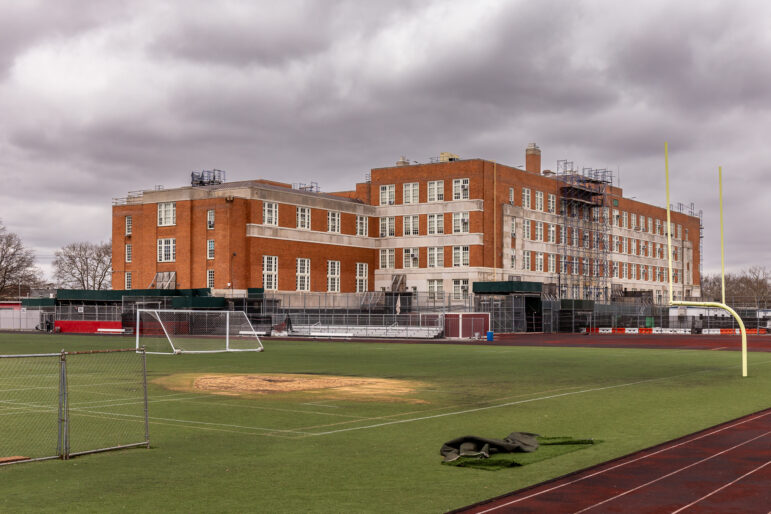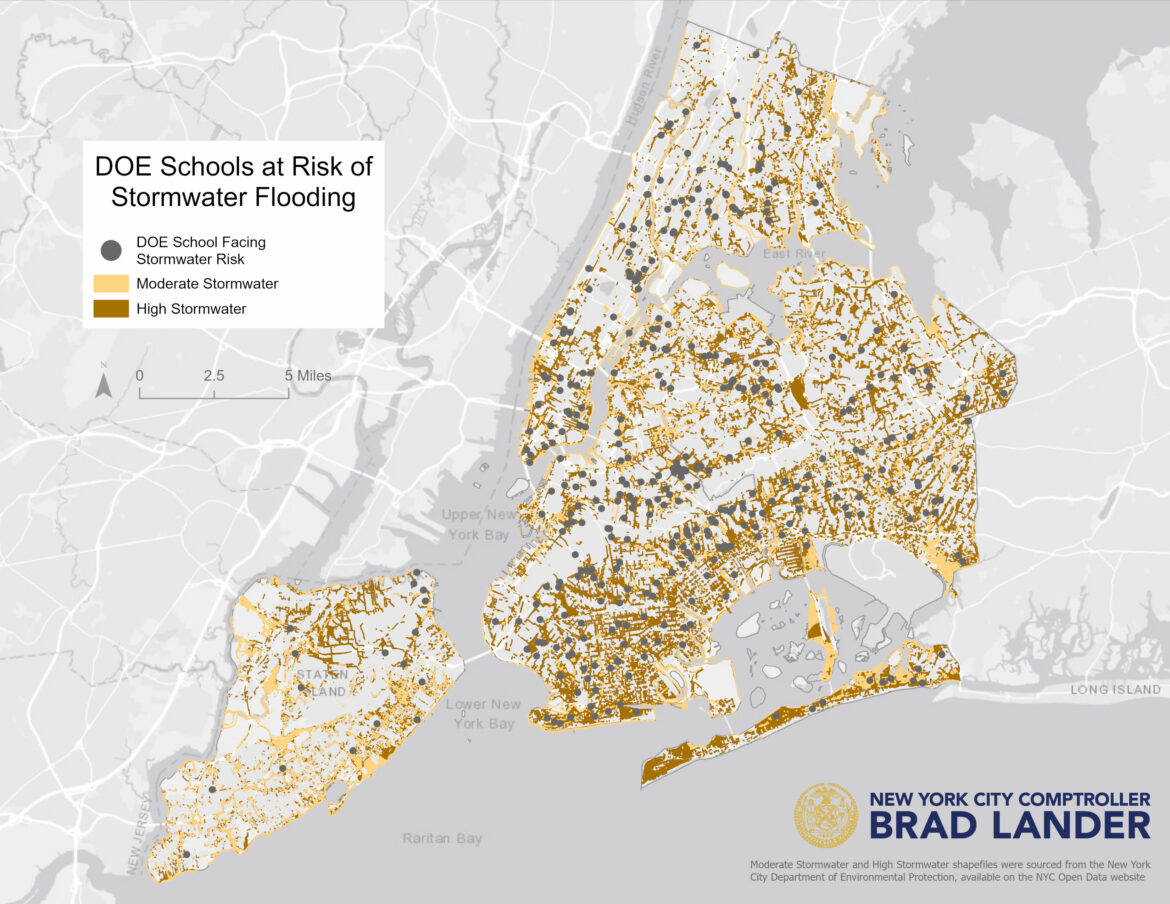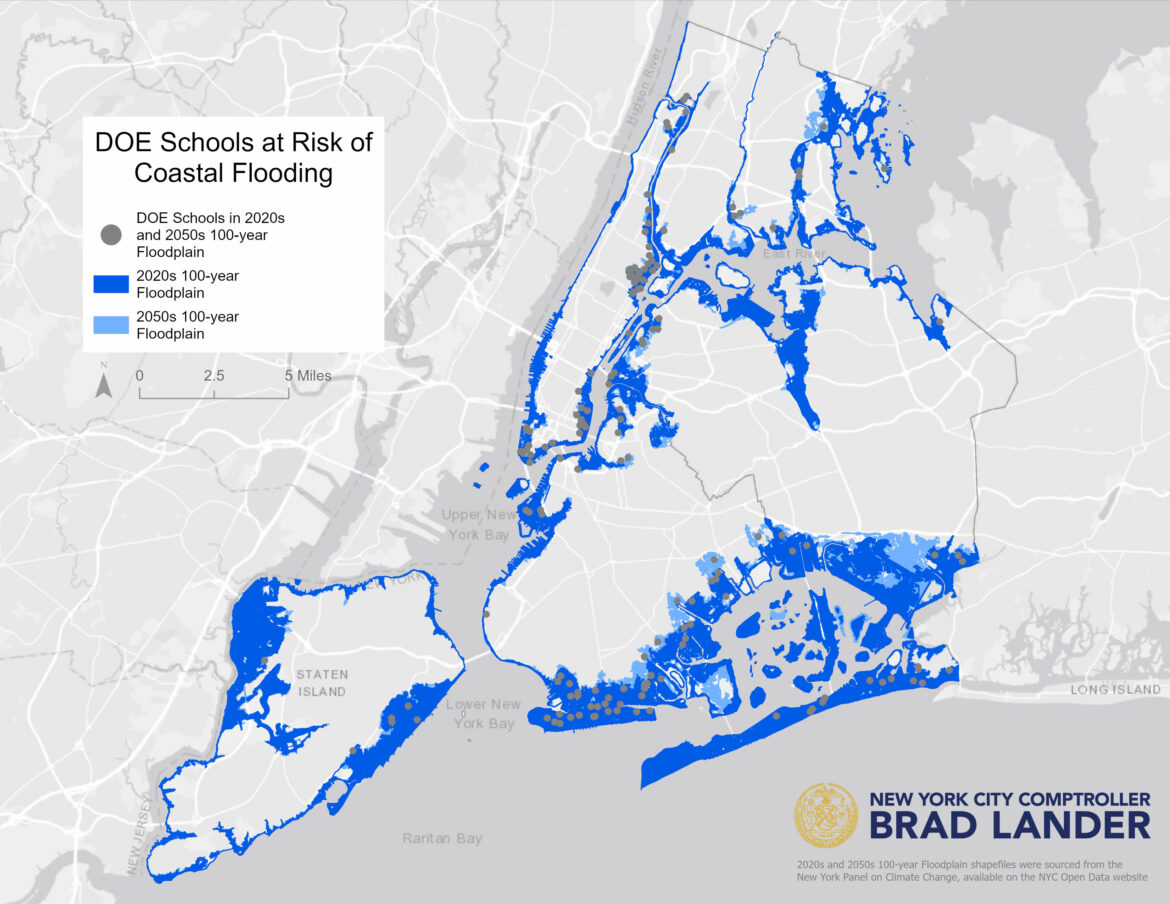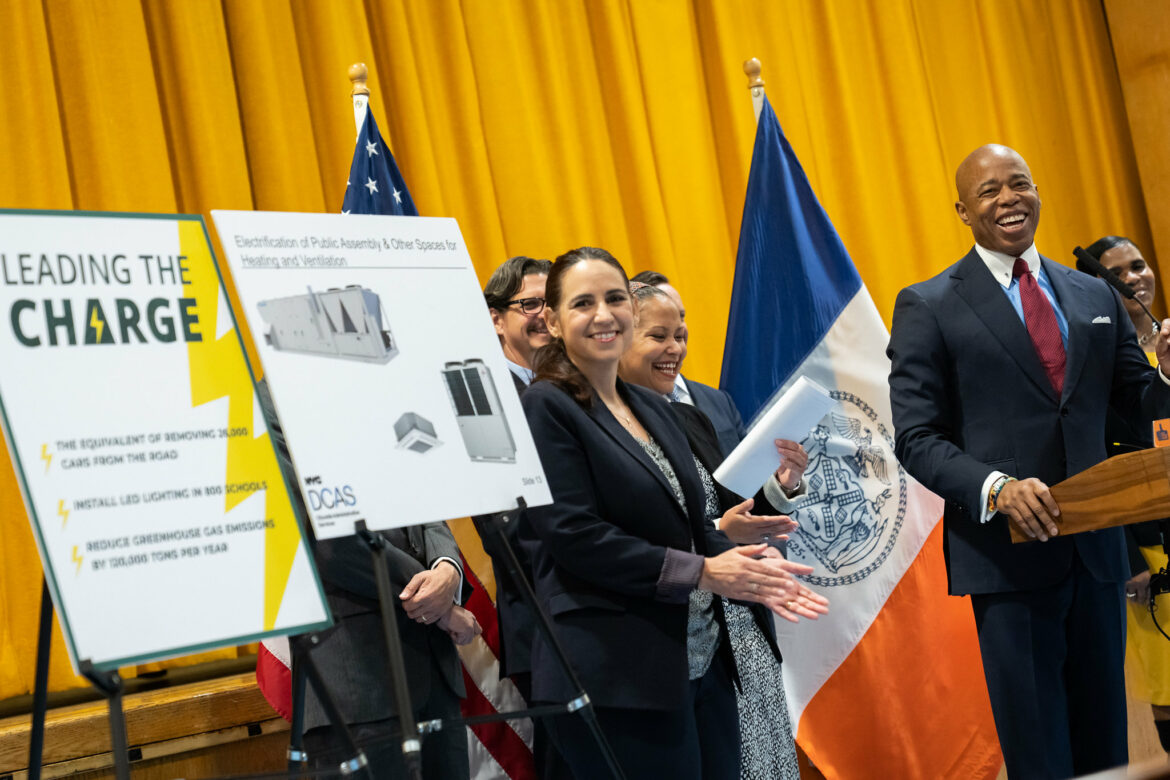More than a quarter of the city’s public school buildings are currently at risk from extreme stormwater flooding, according to an analysis by the Comptroller’s Office shared with City Limits. Teachers, students and environmental groups are pushing for more weather-resilient schools.

Adi Talwar
The Lafayette Educational Complex in Bensonhurt, Brooklyn, which houses Leaders High School. The building flooded in September during a day of heavy rains.On Sept. 29, Gabriel Fontes was on his way to teach 10th grade English when he was met with a river of sewage-infested stormwater at an intersection outside his school. Students and staff at Leaders High School in South Brooklyn were forced to wade through waves of knee-high dirty water to make it into the building.
“The water was brackish and things were floating in it,” Fontes recalled. “I didn’t think the conditions were safe so I spent the morning helping students get home.”
A flash flood that day caused 356 schools to experience flooding that required cleanup, according to the Department of Education (DOE). A citywide state of emergency was declared as half of the city’s subway lines shut down and Brooklyn, one of the hardest hit areas, accumulated more than seven inches of rain.
The basement at Leaders High School, where students check in every morning and where the cafeteria is located, was covered in murky water.
“I was having thoughts like: if we’re stranded here for multiple days, we won’t have enough food or water,” said another teacher at Leaders who asked not to be identified.
Teachers across the city fear this isn’t the last time their public school will be at the mercy of extreme weather conditions.
Over a quarter of the city’s public school buildings, 28 percent, are currently at risk of extreme stormwater flooding, according to data that the City’s Comptroller’s Office shared with City Limits. Of those 383 schools, over 41 percent are located in Brooklyn and over 28 percent in Queens.

NYC Comptroller’s Office
A map of schools at risk of stormwater flooding.And 9.5 percent of school buildings are situated in a 100-year floodplain, or areas that face a 1 percent annual risk of flooding due to coastal storms, the Comptroller’s data shows. That number will increase to almost 12 percent by 2050 as climate change worsens.
Environmental groups, teachers and students who spoke with City Limits want schools that are more resilient to extreme weather and demand that educational facilities stop running on the very fossil fuels that contribute to global warming.
The city has built green infrastructure in school yards to catch rainwater, installed flood barriers at around 40 schools hard-hit by Superstorm Sandy, and requires that every new school built adheres to “flood resistant construction standards.” In 2022, Mayor Eric Adams launched a $4 billion dollar initiative to convert 100 existing schools to all-electric heating by 2030.
But environmental advocates say the resiliency efforts—and the mere five schools that got their funding approved for the electrification initiative so far—feel like a drop in the bucket for New York City, the largest public school system in the country with over 1,800 schools. And students aren’t okay with that.
“This is a disaster and [Mayor Adams] doesn’t get the urgency,” said Matenen Kourouma, a 17-year-old high school student in Queens and member of the environmental group TREEage. “I think it’s super, super important that we push for schools that are not relying on fossil fuels and that are safe because our safety is the most important thing above everything else.”
‘Long way to go‘
During Liat Olenick’s first year on the job as an elementary school teacher, Hurricane Sandy damaged 200 schools and shut down classes for a week. More recently, on Sept. 29 when the flash floods hit, two Brooklyn based public schools where she has worked—P.S. 414 and P.S. 321—got flooded.
“The climate crisis is impacting New York City schools, more and more,” said Olenick, who is also a member of the group Climate Families NYC.
“Most of the school buildings in the city are pretty old and they’re not built for a changing climate. They really need upgrades not only so they can be powered by renewable energy, but also to improve indoor air quality and become more flood resilient so that kids can be in school and learn,” she added.
According to data from the Comptroller’s Office, by 2050, there will be 77 public schools facing a dual threat: at risk of being hit by “high” intensity stormwater events—defined in the analysis as 3.5 inches of rain per hour—while also located on a floodplain that is vulnerable to coastal flooding.

NYC Comptroller’s Office
A map of the city schools that fall into the 50- and 100-year floodplains.The 100-year floodplain maps designed by the Comptroller’s office were developed using data from the Federal Emergency Management Agency (FEMA). The stormwater data was generated by compiling information from both the New York City Panel on Climate Change and New York’s Department of Environmental Protections (DEP).
“Due to climate change, we’re unfortunately seeing that once in a generation storms are happening with a lot more frequency than they used to,” said Louise Yeung, chief climate officer in the Comptroller’s office. “We need to invest in community resiliency so that New Yorkers better withstand and bounce back from these kinds of events that are happening all the time.”
By the 2030s, annual precipitation is expected to increase up to 10 percent, according to the New York City Panel on Climate Change (NPCC). By the 2050s, the Big Apple is likely to experience annual temperatures that are over 4 degrees warmer. That increase will lead to more heat waves, storms, and rising sea levels “that will threaten our infrastructure and the lives of New Yorkers” according to the Comptroller’s Office.
A spokesperson for the Department of Education said in an email that the “safety and wellbeing” of the city’s students is a “top priority.”
“As climate change continues to impact our city, we are working to ensure our school buildings are increasingly sustainable and retrofitted to withstand new inclement weather incidents,” the spokesperson added.
Apart from the New York City School Construction Authority (SCA) installing flood barriers at 40 schools, the administration has built or is still in the process of building green playgrounds in 100 school yards to act as sponges, absorbing and diverting rainwater during storms.
Safeguarding classrooms from extreme weather events goes beyond fortifying educational facilities themselves, the SCA points out. The administration has also been revamping the drains and building green infrastrucuture “in the neighborhoods surrounding our schools.”
“Over the last 10 years the Department of Environmental Protection (DEP) has invested $5.7 billion to upgrade all drainage systems, including sewers, across the city and is planning to invest more than $10 billion for similar upgrades over the next decade,” a DEP spokesperson said in an email.
But deeper resiliency efforts could pose a challenge for the city, especially as the current administration looks to rein in spending.
“The task of maintaining the existing buildings stock in a good state of repair, never mind making them resilient to climate change, costs billions of dollars annually,” said Shino Tanikawa, an environmental advocate and member of the Board of Regents in the state’s Education Department.
“To the extent possible, I think the School Construction Authority and the Department of Education both tried to incorporate climate improving measures into whatever work they do in building maintenance and renovations, but we have a long way to go,” she told City Limits.
Climate change resiliency doesn’t get “elevated” to the level of other mounting issues the city’s schools face, like reducing class sizes and addressing the youth mental health crisis, Tanikawa added.
“Some schools don’t even have libraries,” she explained. “If you ask a student what they think about this they might say: why do we have to choose between a dance room and climate resilience? Why can’t we do both? And that’s actually the right answer.”
Part of the solution
Environmental advocates argue that investment in retrofitting schools to resist climate change will save the city money down the line.
“Hurricane Sandy cost the city $19 billion in damages. And we know that climate change disasters like that are happening more frequently,” said Jenille Scott, climate director at the environmental group ALIGN. “So if we’re not investing in upgrading our schools and developing that resilience to expected storms now, we will end up spending more money to fix the damage later.”
That also means making sure school buildings themselves aren’t contributing to the problem.
Most of the city’s K-12 schools are powered by oil and gas, fossil fuels that contribute to global warming and are among the biggest public polluters in New York City, according to ALIGN. These facilities are often old buildings that don’t retain hot and cold air well.
By switching out old cooling and heating systems for more efficient ones powered with non-polluting electric energy, advocates hope schools will become part of the solution to fighting climate change.
The upfront investment will pay off in the long run via major savings on energy bills, supporters say. “New York City public schools spend $275 million per year on energy costs alone,” ALIGN highlighted in a 2022 report.
The Department of Citywide Administrative Services has set aside $1 billion for school electrification. That’s in addition to the $4 billion initiative, announced by Mayor Adams in late 2022, to complete or begin converting 100 existing schools to all-electric heating by 2030.

Ed Reed/Mayoral Photography Office.
Mayor Eric Adams announcing $4 billion for school building electrification in October 2022. Five school buildings out of the expected 100 have been approved for the upgrades so far.The Mayor’s Office of Climate and Environmental Justice (MOCEJ) says $400 million of those funds have been distributed to the School Construction Authority’s current budget. The office has suggested the inclusion of another $1.4 billion for the construction authority’s next five year capital plan that spans from 2025 to 2029.
But funding has only been approved for five schools so far, and only three of them have entered the construction phase. With so many public schools left to convert, ALIGN fears the city isn’t moving fast enough.
The group launched the Green Healthy Schools campaign, which pushes for the electrification and installation of other environmentally friendly upgrades in 500 public schools by 2030 and all schools by 2040.
“We’re focusing on the schools already in the pipeline and looking to develop our capacity before we expand the number of schools we plan to retrofit,” said Kathleen Schmid, deputy executive director at the Mayor’s Office of Climate & Environmental Justice, in an email.
“However, we are covering more ground than just our commitment to retrofit schools—since 2022, all new school buildings were designed to be all-electric,” she added.
Gov. Kathy Hochul last month also announced $100 million for construction projects that aim to decarbonize public schools. All public school districts across the state are eligible to apply if they are designated as high-needs, or located in a disadvantaged community.
Without adequate action, environmentalists say education will be increasingly disrupted by extreme weather.
“I imagined or fantasized that my son’s childhood would still be largely untouched by climate change. That we were going to get our issues together as a society in time to make life better for him,” said Lauren Phillips, an attorney at the Natural Resources Defense Council and mother to an almost 2 year old. “But my poor kid has had his daycare flooded and shut down by wildfire smoke, and he’s never even had a normal snow day.”
“It just sort of breaks my heart that his life has barely begun and already his routine, his ability to be with his friends, his teachers at the school that he loves, has been disrupted twice by climate disasters just in his first year of school,” she added.
To reach the reporter behind this story, contact Mariana@citylimits.flywheelstaging.com. To reach the editor, contact Jeanmarie@citylimits.flywheelstaging.com









One thought on “How Climate Change is Hitting NYC Public Schools”
Addressing the vulnerability of NYC’s public schools to extreme weather is imperative. Urgent action and investment in resilient infrastructure are crucial for the safety and well-being of students and staff.